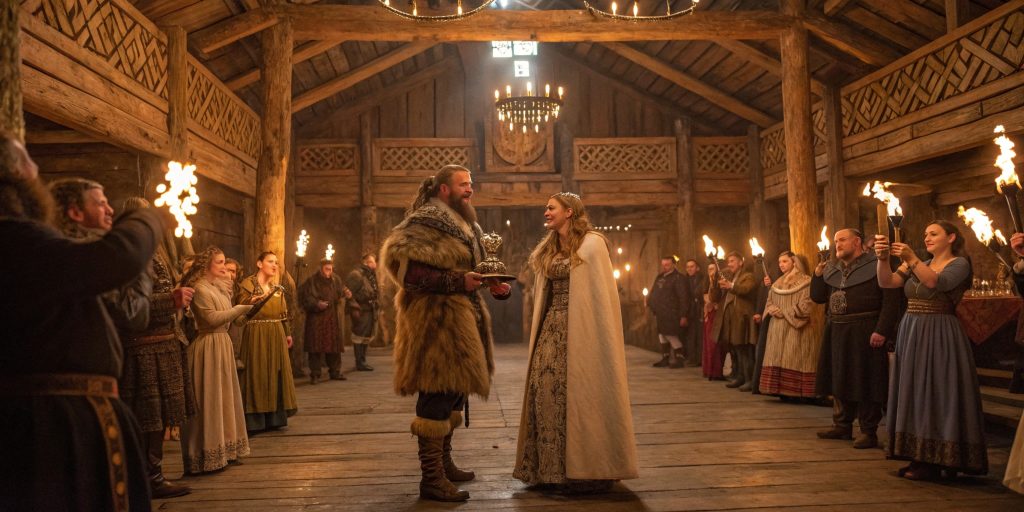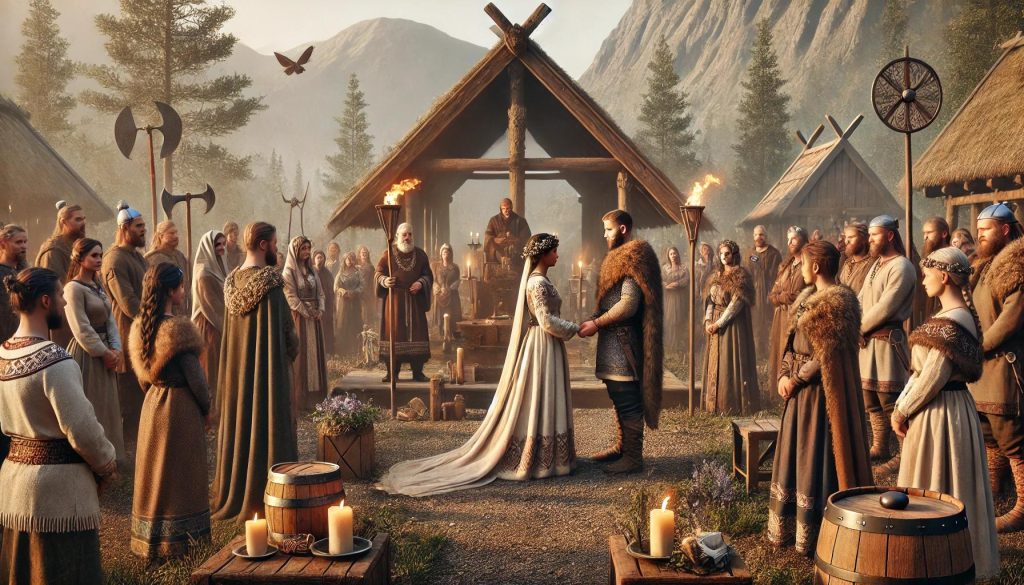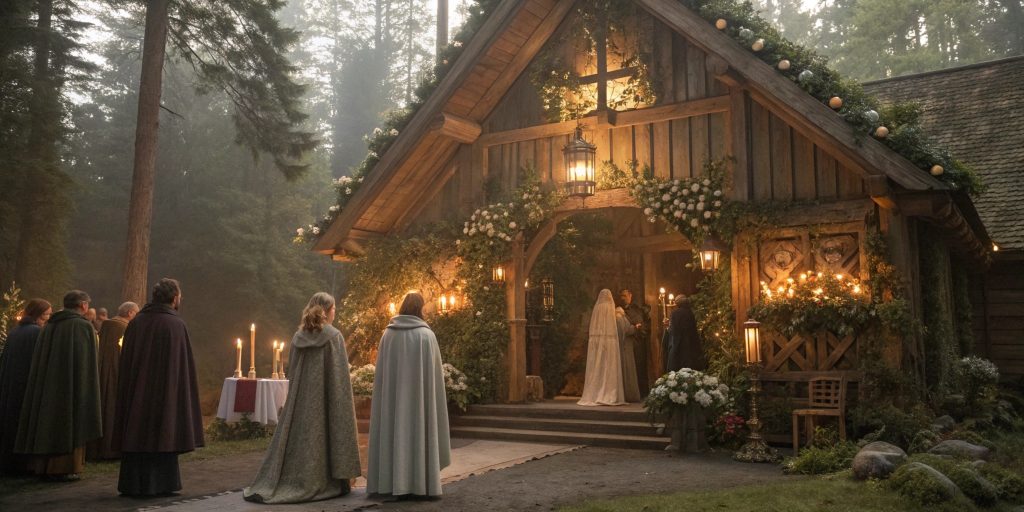Daily Life in the Viking Age, Vikings
What Age Did Vikings Marry?
The Viking marriage age greatly changed, influenced by the saga’s expectations. It depended on social class, family ties, and the community’s expectations. Knowing about Norse marriage helps us better understand Viking traditions.
Marriages were often about politics and money. They helped families get stronger together. Looking into the Viking marriage age shows us how complex their society was.
Understanding Viking Marriages
Viking marriages were a mix of personal and societal needs, often accompanied by traditional Viking wedding rituals. They were not just about love but about building family alliances. In Norse culture, marriage contracts were key to outlining what each partner expected from the other.
Marriage in Norse society was about loyalty, working together, and sharing duties. These agreements showed the couple’s commitment and strengthened family bonds. Families chose partners based on what they could offer, like land, resources, and protection.
Norse myths, like those of Freyja, the goddess of love and fertility, influenced these customs and the choice of wedding vows. Her stories made marriage a celebration of love and a duty to the family. Knowing this helps us understand Viking relationships and the importance of marriage in their society.
The Age of Marriage in the Viking Age
The Viking marriage age changed a lot between men and women. Girls could get married as young as 12 or 14. These early marriages helped strengthen family ties and alliances.
Men, on the other hand, usually got married in their late teens or early twenties. This shows that there were different expectations and levels of maturity for men and women in Viking society.
Many factors affect when someone gets married, including their situation, social class, and how long they were expected to live. Noble families might have planned their marriages more carefully. Lower-class people often married younger because they needed help at home.
The age of marriage in the Viking Age shows how complex their society was. It highlights the importance of family in their lives, as reflected in the Icelandic sagas.
Norse Marriage Traditions
Norse wedding traditions are deeply rooted in ancient customs and are often celebrated with specific attire. They reflect the values and beliefs of Viking society. Handfasting was a key tradition where couples were symbolically tied together.
This ritual showed the couple’s commitment to each other. It was a public declaration of their intentions.
The exchange of gifts, including Viking wedding rings, was also important in Norse marriages. It showed the bond between families. Gifts could be practical items or precious tokens.
Each gift symbolized a promise of support and continued alliance, reinforcing the importance of familial approval in marriage customs.
Shared meals were a vital part of wedding ceremonies. They united families and friends to celebrate the couple’s new life. These communal gatherings emphasized the role of community in forming strong matrimonial ties.
Overall, Norse marriage traditions highlight the significance of family and shared values. They show how ancient customs shaped social structures and fostered a sense of belonging within Viking communities.
Viking Wedding Traditions
Viking wedding customs were full of meaning and tradition, often passed down as heirlooms through generations. They showed the deep spiritual and communal ties of the Norse people. The blot, a sacrifice to the gods, was a key part of these ceremonies. It was a moment for the community to celebrate the union of the bride and groom.

After the blot, wedding feasts became a big part of Viking rituals. These feasts brought together family, friends, and neighbors. Everyone sang, danced, and feasted, showing their joy and support for the couple.
- The exchange of swords often symbolized the couple’s commitment to protect one another.
- Rituals involving gifts from the families highlighted the merging of two households.
- Communal celebrations emphasized the importance of shared joy and support.
Viking weddings were more than just personal events. They were vibrant festivals celebrating life, love, and unity. Each part of the ceremony helped create a new family, strengthened community ties, and wished the couple well for their future together.
Significance of Age in Viking Weddings
The marriage age in Viking society showed deep cultural insights. It showed how relationships and family structures worked, emphasizing the significance of wedding vows. People usually get married in their late teens or early twenties.
This age was seen as when one was ready for family duties. It was believed that one was mature enough for married life by then.
Marriage ages were highly culturally important. Certain ages were linked with fertility and prosperity. For example, young marriages showed a family’s desire for growth and stability.
On the other hand, later marriages focused on personal achievements before family duties, showing how age was seen as a sign of readiness.
- Marriage at a younger age promoted immediate family expansion.
- Individuals who married later often gained social respect due to their maturity.
- Cultural expectations shaped views on appropriate marriage ages, reflecting broader societal norms.
This shows that age was not just about personal milestones but also readiness for marriage in Old Norse culture. It was also key in Viking culture’s values and traditions. Today, we still see how these customs influence our views on age in marriage.
The Role of Families in Viking Marriages
In Viking culture, family was essential, and the groom would often seek approval from both families. It was a big part of their society and showed in their wedding customs. When two people got married, it was not just about them. It was also about joining two families together.
Parents had a big say in who their children married. This showed how important family was in choosing a partner. It was all about making strong family ties, ensuring that the Viking groom and bride would have support.
Marriages were often planned to help families grow stronger. Families wanted to get richer or gain more land, so they carefully chose their children’s partners.
Planning a wedding was a team effort. The couple would involve both families in the preparations. Families worked together to ensure the wedding was special, as it was a significant event in their saga. This shows how important the family was in Viking society.
- Parental consent was crucial in selecting a spouse.
- Arranged marriages enhanced family alliances.
- Lineage often influences marriage choices.
- Families collaborated in wedding planning.
- Strong familial bonds provided community support.
Choosing a Wedding Date in Viking Culture
In Viking culture, choosing a wedding date was not just personal. It was tied to the Norse calendar and the seasons. They picked dates that matched the lunar cycles and the harvest times. This way, weddings were celebrated when food and resources were plentiful.
Norse traditions made some days better for weddings than others. These days were seen as lucky. The gods were believed to bless couples who married on these days. Important factors in choosing a wedding date included:
- Lunar Cycles: Many couples chose dates based on the moon’s phases, believing that certain lunar stages would bring prosperity.
- Agricultural Seasons: Weddings were often timed to follow harvests, ensuring families could gather and celebrate without worrying about ongoing farm work.
- Significant Festivals: Couples planned their weddings around important Norse celebrations, integrating community and religious significance into their wedding day.
Choosing a wedding date was not just about the couple. It was also about following cultural practices. This made the wedding more meaningful in Viking society, as loved ones would surround the couple.
Norse Pagan Wedding Traditions
Norse wedding rituals show a rich mix of cultural customs passed down for generations. These traditions show the importance of marriage and the Viking Age’s social norms. They also highlight the bond between the bride and groom through symbolic gestures and practices.
Rituals and Customs
Several key rituals make Norse weddings special, showing the importance of unity and community. Common customs include:
- The handfasting ceremony, where the couple’s hands are tied together, symbolizes their union.
- Shared meals emphasizing fellowship among family and friends are crucial to the celebration.
- Drinking rituals involving toasting to the gods and ancestors invoke blessings for the new couple.
These practices strengthen the bond between the bride and groom. They are rooted in history and cultural importance.
Historical Context
The evolution of Norse wedding rituals is fascinating. It shows how cultural customs have changed over time. Early practices were influenced by Norse mythology and agrarian lifestyles. Today, Nordic weddings still hold onto these ancient traditions.
Modern ceremonies often mix old and new rituals. This keeps the Viking heritage alive, allowing the stories of Viking history to wash away with time. It also shows the lasting cultural identity of the Nordic people.
Nordic Wedding: A Cultural Exploration

Old Norse wedding traditions are deeply rooted in history and culture. They connect the past and present in Scandinavian weddings, and old practices still hold great value in places like Iceland, Norway, and Denmark.
The bridal crown symbolizes purity and unity, often paired with wedding attire that reflects Viking history. It shows how Viking marriages were tied to community and family, and this tradition shows the lasting impact of Norse culture on today’s weddings.
Scandinavian weddings also include handfasting and feasts, honoring the gods like Thor, which are central to Viking wedding rituals. These highlight the importance of family and celebration. They show how love and partnership have been valued for generations. The ongoing use of these traditions makes them relevant today.
Viking Wedding Ceremony Elements
The Viking wedding was full of traditions and rituals. These showed the importance of the union between the bride and groom and celebrated the community. The following rituals, including exchanging wedding rings, were vital in showing the bond formed during this special event.
Rituals Involving the Bride and Groom
Many bride-and-groom rituals, including exchanging circlets, made the Viking wedding special. Each ritual had a deep cultural meaning and brought the community closer.
- Symbolic Presentation of Swords: This act showed strength and protection. The groom gave a sword to the bride, meaning he would protect her and their future.
- Sharing of Mead: The couple drank mead, symbolizing fertility and happiness. Drinking mead together showed their commitment to each other.
- Taking of Vows: The couple made vows, promising to be faithful and supportive. This was a moment when they told the community about their plans.
These wedding elements celebrated the bond between the bride and groom. They also showed their connection to their heritage and the community. Each ritual was special in Viking culture, starting their new life together.
Bottom Line
Viking marriages were filled with customs and practices shaped by age, culture, and family roles. People usually get married at a young age, following society’s rules and traditions.
This early marriage helped build families in Norse society and has a lasting impact on today’s Nordic culture.
The influence of Norse traditions is still seen in today’s weddings. Many rituals and customs from the Viking Age are still used. This shows how Viking weddings have shaped our modern celebrations.
Looking back at Viking wedding customs, we see their lasting impact. These customs reflect the values and beliefs of the past, deeply rooted in Icelandic culture. They also show how Viking traditions continue to influence us today.

